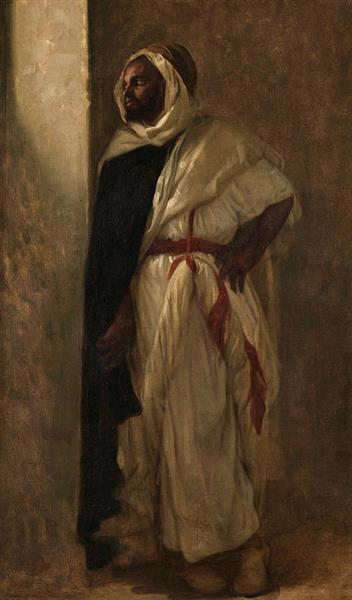Beskrivelse
Alexandre Cabanel's "Arab" painted in 1880 is a stunning example of the mastery of the French painter, known for his ability to portray the human figure and his contributions to the academic movement of the 19th century. In this painting, Cabanel captures the essence of an exotic and seductive beauty, reflecting both the fascination with the Orient and the ideal of beauty that prevailed at the time.
The painting features a young Arab woman, whose reclining figure becomes the focal point of the composition. The modeling of the body is particularly notable, as Cabanel employs a delicate chiaroscuro technique that highlights the soft, voluptuous shapes of her form. The disposition of the body, with a subtle turn to the left, evokes a sense of naturalness and grace. The artist uses light to accentuate the contours of her figure, imbuing it with an almost ethereal glow that separates it from the dark background.
Colour plays an essential role in this work, where warm tones predominate. From the golden hue of the woman’s skin to the rich hues of the fabrics surrounding her, the palette is a tribute to the opulence of the East. The textiles, which are a mix of deep blues and golds, lend an air of luxury and sophistication, while contrasting beautifully with the skin of the character. The smooth transition between colours, combined with the ornamental details of the clothing, show Cabanel’s skill in weaving a visual narrative that envelops the viewer.
The young woman’s face is one of the most enigmatic elements of the painting. With delicate features and a gaze that seems both inviting and introspective, the figure is a symbol of the European fascination with the mystery of the Arab world. Her expression reflects a duality; she seems to be both in contemplation and invitation, which adds a complexity to her character. Cabanel, with his focus on idealized beauty, distances himself from any stereotypical representation, giving life to a woman who is both concrete and ethereal.
The historical context of the work is also relevant. During the 19th century, interest in the Orient—what we today conceptualize as “Orientalism”—emerged as a cultural phenomenon in Europe, fueled by colonial exploration and Romanticism. Cabanel, in his quest for beauty, immersed himself in this wave of interest, creating works that avoid criticism of culture and instead focus on aesthetics and the ideal of beauty. “Arab” is a clear reflection of this trend that, while aesthetically valuable, does not escape contemporary critics who question its representation and the colonial context of art.
In the current of academic art, Cabanel clings to traditional techniques that emphasize detail and perfection in figuration. His work can be compared to that of other academics such as William-Adolphe Bouguereau, although Cabanel tends to lend an additional air of sensuality to his figures. It is important to note that, despite the popularity of these representations in their time, they face a reappraisal in the current artistic context, where the dialogue on cultural representation becomes increasingly relevant.
Alexandre Cabanel’s “Arab” is, without a doubt, a captivating work that invites us to reflect on the intersection of beauty, culture, and history. When confronted with this piece, we are struck not only by its aesthetics, but also by the complexity of its place in the Western art canon and its legacy in the representation of the “Other.” The work resonates as a symbol of a time when curiosity about the unknown fused with masterful artistry, producing work that continues to fascinate modern viewers.
KUADROS ©, a famous painting on your wall.
Hand-made oil painting reproductions, with the quality of professional artists and the distinctive seal of KUADROS ©.
Painting reproduction service with satisfaction guarantee. If you are not completely satisfied with the replica of your painting, we will refund 100% of your money.

